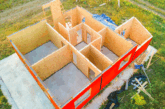
An integrated weather barrier system is heralding a new era in weatherproofing for timber frame homes. Brian Adams, Arclin’s Senior Director of International Business explains more.
In May, Arclin announced it is launching Arctek® Dryshell™, an integrated weather barrier system that provides an alternative to traditional housewrap products for timber framed homes. Here, we speak to Brian Adams Senior Director of International Business at Arclin to find out more.
Arclin is a US manufacturer, so for those who don’t know, tell us a little about the company?
Arclin is based in Atlanta and manufactures polymer and engineered products for industrial applications in the construction, agricultural, weather and fire protection sectors. We recently purchased UK panel processor Trade Fabrication Systems (TFS) to establish and grow our market share in the UK and Europe.  What is Arctek Dryshell?
What is Arctek Dryshell?
Unlike any other weatherproofing solution for timber frame homes in this market, Arctek Dryshell is a proven and established technology in America. We believe it will be a real game changer for housebuilders across the UK and Europe. The precision-engineered overlay is thermally bonded to OSB or plywood sheathing boards in the factory. This means timber frame walls and roofs, SIP systems and cassettes are delivered to site with the weatherproofing in place, massively speeding up installation.
As a result, it delivers a weather-tight shell more quickly, overcoming the risk of moisture penetrating timber panels during construction, whilst its vapour permeability allows humidity to escape the building envelope to avoid interstitial condensation.
Why have you launched Arctek Dryshell in the UK now?
The time is right. There’s currently a significant and growing housing crisis across Europe. In the UK alone, there’s a deficit of about four million homes, so there’s pressure on housebuilders to quickly and efficiently deliver more homes. At the same time, stricter legislation means these homes must be more sustainable and achieve high standards of quality and performance.
We know approximately 40% of manmade emissions come from construction, so new homes must be both energy efficient and low carbon in construction. Timber is a good insulant and using it in construction can reduce the embodied carbon of a property by up to 60%. As a result, the Government published the ‘Timber in Construction Roadmap’ to grow more trees and unlock the potential of this construction material.
There’s a huge opportunity for growth. England’s use of bricks and mortar means it’s lagging behind other markets – just 9% of new homes are built from timber compared to 92% in Scotland. But this will change. We commissioned a report by analysts Alfry which showed the ‘addressable market’ in Europe for OSB, plywood and SIPs for timber frame construction will rise from 35 million m2 annually to 50 million m2 in 2025. The greatest potential is seen in the UK, with a current addressable market of 13 million m2.
This solution will help housebuilders overcome the competing pressures of needing to comply with stricter legislation while delivering homes at scale and speed so they can tap into this growing market.
 How does the product differ from traditional solutions?
How does the product differ from traditional solutions?
The obvious difference is how it’s installed. Housewrap products are fixed to the outer face of timber framed structures. This takes time and effort. Installers must ensure laps go in the right direction and undertake tricky installation details around window and door openings.
In contrast, Arctek Dryshell is applied within the factory. This means both the timber frame and the weatherproofing layer is installed in one seamless process. Once the panel has been installed, there’s no details, and joints are simply taped to provide instant protection for the substrate.
What are the benefits to housebuilders?
Using timber products with Arctek Dryshell removes an entire stage of the construction process, significantly reducing time and costs. It means skilled tradespeople can focus on what they do best rather than spending time installing housewrap.
The product also supports regulatory compliance. Under Part L, every new home must be tested for airtightness. Products are selected for performance, but that can be undermined by poor installation.
Housewrap products are loose. Failures in correct detailing around doors and windows can reduce performance, but the biggest issue is tearing. This can happen during installation, but housewrap can also be inadvertently damaged by other trades, and this minor damage can become a full-scale rip if it’s caught by the wind. As a result, moisture can penetrate behind the wrap and into the frame structure, and airtightness is compromised too.
Because Arctek Dryshell is thermally bonded to the wood, it won’t be damaged on site. It creates a waterproof barrier for the wood-based panel, acts as a vapour control layer, promotes thorough drying to the outside and offers better prevention of air leakage than housewrap products.
As the housing crisis continues to grow, we know pressure on the industry will only increase. So, this launch is about helping to address fundamental issues for housebuilders that will ease those pressures – performance, quality, time and cost.
For more information on Arctek Dryshell visit Arctek® Dryshell™.
For more on Arclin visit Arclin.

